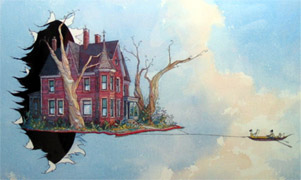
| School Information System |
 |
|
 | Newsletter signup | Send us your ideas
| Newsletter signup | Send us your ideas
May 2, 2008Art Without CraftOn the website www.michelangelo.com/buon/bio, I learn that: "When Michelangelo turned 13-years-old he shocked and enraged his father when told that he had agreed to apprentice in the workshop of the painter Domenico Ghirlandaio. After about one year of learning the art of fresco, Michelangelo went on to study at the sculpture school in the Medici gardens and shortly thereafter was invited into the household of Lorenzo de' Medici, the Magnificent...During the years he spent in the Garden of San Marco, Michelangelo began to study human anatomy. In exchange for permission to study corpses (which was strictly forbidden by The Church), the prior of the church of Santo Spirito, Niccolò Bichiellini, received a wooden Crucifix from Michelangelo (detail of Christ's face). But his contact with the dead bodies caused problems with his health, obliging him to interrupt his activities periodically.My apologies for quoting at such length from a biography, but I have seen his Pietà in Rome on several occasions, and it seems clear to me that it took a gifted young man, with great acquired skill in the craft of shaping marble with hammer and chisel, perhaps two years to achieve this masterwork. Fast forward to the modern period, when we learn from The Boston Globe, in an article in February 2002 by Dave Barry, that: “...Another important British artist is Damien Hirst. He won the Turner Prize in 1995, for an entry that consisted of (I am not making any of this up) a cow and a calf cut in half and preserved in formaldehyde. Last October, a London gallery threw a party to launch an exhibition by Hirst. When it was over, there was a bunch of party trash—beer bottles, ashtrays, coffee cups, etc.—lying around. Hirst, artist that he is, arranged this trash into an ‘installation,’ which is an artistic term meaning ‘trash that the gallery can now price at 5,000 pounds (sterling) and try to sell to a wealthy moron.’ The next morning, in came the janitor, who, tragically, was not an art professional. When he saw the trash, he assumed it was trash and threw it away. ‘I didn’t think for a second that it was a work of art,’ he later told the press. When members of the gallery staff arrived, they went out and retrieved the artistic trash from the regular trash, then reassembled the original installation, guided by photographs taken the night before.”A similar astounding contrast may be discovered between artists whose works depend on carefully developed skill and great diligence, such as Albrecht Dürer, Jan van Eyck, Hans Memling, and Johannes Vermeer, among hundreds of others, and the newer artists whose work requires no craft at all, as, for example, quoting again from Dave Barry’s Globe article: “The 2001 Turner Prize went to an artist named Martin Creed, whose entry was titled The Lights Going On and Off. It consists, as the title suggests, of lights going on and off in a vacant room. They go on for five seconds, then off for five seconds. That’s it. In other words, this guy got 20,000 pounds (sterling) for demonstrating the same artistic talent as a defective circuit breaker. Here’s the scary part. He deserved to win. I say this because, according to the BBC, his strongest competition was an artist whose entry consisted of a dusty room ‘filled with an array of disparate objects, including a plastic cactus, mirrors, doors, and old tabloid newspapers.’ Some gallery visitors mistook this for an actual storeroom before realizing that it was art. So Martin Creed’s blinking lights probably looked pretty darned artistic to the Turner Prize jurors. The prize was formally presented by Madonna, who said: ‘Art is always at its best when there is no money, because it has nothing to do with money and everything to do with love.’ That Madonna! Always joking! You should know that the artistry of Martin Creed is not limited to blinking lights. Another of his works is titled A Sheet of A4 Paper Crumpled Into a Ball. It’s a piece of paper crumpled into a ball.”So now, instead of hard-earned craft and artistic masterworks, we have junk that shows us that “Art is...everything to do with love.” I am appalled by all this, as one who loves the art of Vermeer, Michelangelo and others, but I am also concerned because some of the same debased and mindless standards are working their way into the expectations for and evaluation of academic writing in our schools. Students are encouraged and rewarded for personal and “creative” writings which seem to be judged by the same standards which gave the Turner Prize for lights going on and off. Students are praised and given prizes for writing brief diary entries which involve as much craft as making breakfast with cereal from a box. Students are “protected” from engaging in the difficult craft of writing just as modern artists seem to have been released from any expectation that art should be the result of a long apprenticeship in a craft, such as sculpture or painting. It is true as was said about learning to play the cello, that “There are no shortcuts” in academic expository writing or in art. Artists and writers who try to take a shortcut and skip learning their craft turn out junk. Perhaps we should consider expecting our students, if not our modern artists, to try for a little higher level of achievement than craft-free junk? “Teach by Example” Subscribe to this site via RSS/Atom:  Newsletter signup | Send us your ideas Newsletter signup | Send us your ideas
|